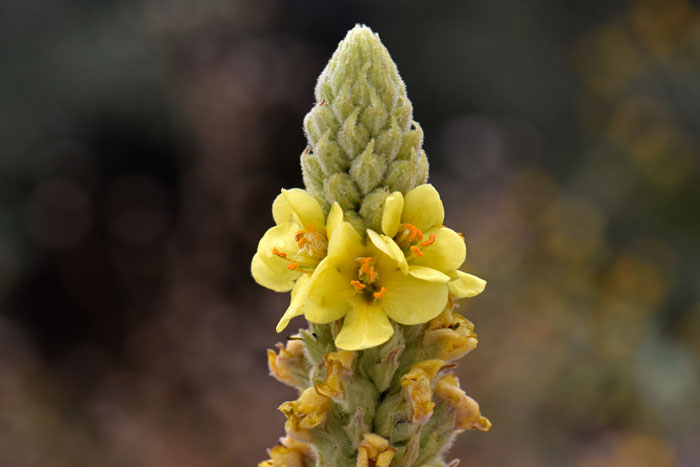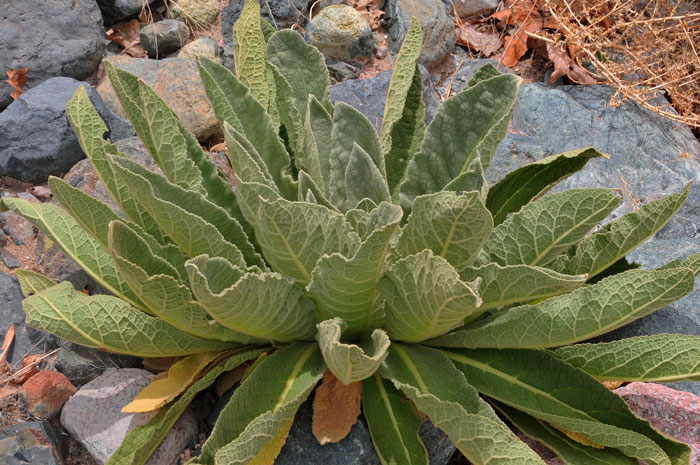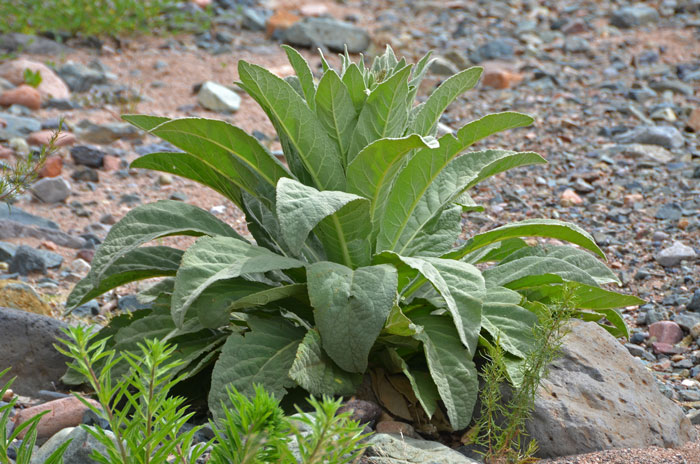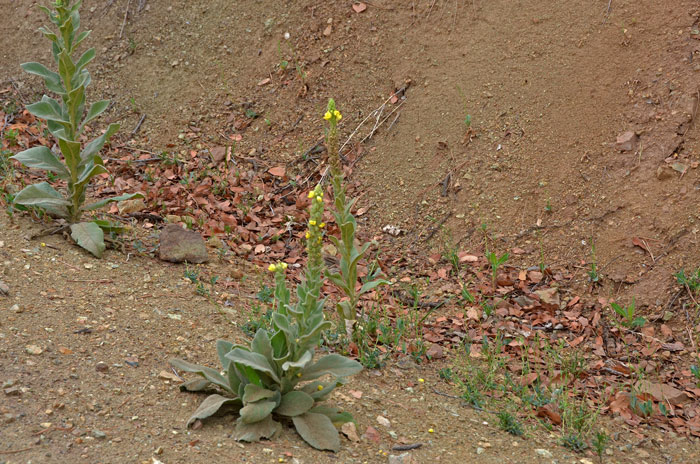Verbascum thapsus, Common Mullein




Scientific Name: Verbascum thapsus
Common Name: Common Mullein
Also Called: Big Taper, Flannel Mullein, Flannel Plant, Great Mullein, Mullein, Velvet Dock, Velvet Plant, Woolly Mullein (Spanish: Barbasco)
Family: Scrophulariaceae, Figwort or Snapdragon Family
Synonyms: ()
Status: Introduced.
Duration: Biennial;
Size: Up to 6 feet or more.
Growth Form: Forb/herb; plants densely woolly-tomentose or with stellate pubescence throughout, not glandular.
Leaves: Green; fuzzy, basal leaves oblanceolate; stem leaves short petioled, lanceolate, long decurrent; margins entire or obscurely crenate.
Flower Color: Yellow; flowers in long thick dense spike-like racemes (terminal inflorescence); flowers short-lived; fruits hairy, egg-shaped, 2-celled capsules which often persists through the winter.
Flowering Season: June to September, Arizona and California.
Elevation: 3,500 and 7,000 feet Arizona and California.
Habitat Preferences: Waste ground, disturbed areas, roadsides.
Recorded Range: Verbascum thapsus is an introduced species that has spread throughout North America. In Arizona it is found through the state in preferred habitats.
North America & US County Distribution Map for Verbascum thapsus.
U.S. Weed Information: In North America Verbascum thapsus can be weedy or invasive according to the following authoritative sources: Listed as weedy by 46 states;
California Invasive Plant Council. 2006. California Invasive Plant Inventory.
Alien Plants in Hawaii.
Weeds of Kentucky and adjacent states.
Weeds of the Northeast, Weeds of the Northeast.
Weeds of Nebraska and the Great Plains.
Invasive exotic pest plants in Tennessee.
Weeds of the United States and Canada.
Wisconsin manual of control recommendations for ecologically invasive plants.
Weeds of the West.
Plants included here may become weedy or invasive.
Invasive/Noxious Weed Information: In North America Verbascum thapsus is listed as a Noxious Weed by the federal government and/or a State.
Colorado, Common Mullein C list (noxious weeds)
Hawaii, Mullein, Noxious Weed
Plants included here are invasive or noxious.
Wetland Indicator: In North America Verbascum thapsus has the following wetland designations:
Alaska, FACU, Arid West, FACU; Atlantic and Gulf Coastal Plain, FACU; Eastern Mountains and Piedmont, FACU; Great Plains, UPL; Midwest, UPL; Northcentral & Northeast, UPL; Western Mountains, Valleys, and Coast, FACU; Hawaii, UPL
FACU = Facultative Upland, usually occur in non-wetlands, but may occur in wetlands
UPL = Obligate Upland, almost never occur in wetlands
Threatened/Endangered Information: No information available.
In the Southwestern United States, Arizona, Nevada, New Mexico, Texas and Utah each have strong3 species of Verbascum, California has 5 species. All data is approximate and subject to taxonomic changes.
Comments: Common Mullein flowers do not live long and they may be open to pollination for 1 day from just before dawn until mid-afternoon.
For a complete and thorough review of this species here is an excellent academic paper prepared by the U.S. Forest Service: Fire Effects Information System; Verbascum thapsus.
Verbascum thapsus has been used for a host of purposes by North American indigenous peoples.
Abnaki Drug, Pediatric Aid, Roots used to make a necklace worn by teething babies.
Atsugewi Drug, Antirheumatic (Internal), Decoction of leaves taken for rheumatism.
Catawba Drug, Dermatological Aid, Poultice of smashed leaves applied to swellings, bruises and wounds.
Cherokee Drug, Cough Medicine, Compound decoction of leaf taken with brown sugar or honey as a cough syrup.
Creek Drug, Cough Medicine, Compound decoction of root taken for coughs.
Delaware, Oklahoma Drug, Cough Medicine, Compound containing leaves taken for catarrh, coughs and lung trouble.
Hopi Drug, Anticonvulsive, Leaves smoked with onosmodium for 'fits,' craziness and witchcraft.
Iroquois Drug, Antidiarrheal, Compound decoction of roots and leaves taken for diarrhea with blood.
Iroquois Drug, Ear Medicine, Poultice of heated leaves applied for earaches.
See ethno-botanical uses at Native American Ethnobotany, University of Michigan, Dearborn.

